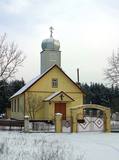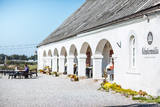| Nr | Name | Beschreibung |
|---|---|---|
|
Lielais Liepu kalns ir Latgales augstienes Rāznavas pauguraines augstākā un Latvijā trešā augstākā virsotne (289,3 m v.j.l.). Lielpaugura relatīvais augstums ir 86 m! Skatu torņa platforma ir šobrīd augstākais Latvijas punkts (323 m.v.j.l.), kas sasniedzams ar paša kājām! Liepu kalna apkārtne ir labiekārtota. |
||
|
Das Gehöft befindet sich auf dem Kaibēni Berg (226m ü.M.) 7km entfernt von Ineši. Es ist nominiert als das älteste memoriale Museum Lettlands (seit 1929). Die Gebäude des Hofes sind im 18. und 19. Jh. Erbaut und man kann die eigenhändig gebaute Veranda, Treppen, Wandschränke, das imitierte Parkett der Volkslehrer und Schriftsteller Reinis (1839-1920) und Matīss (1848-1926) Kaudzīte besichtigen, auch die von R. Kaudzīte gebaute Drechselbank. In der Remise gibt es eine Ausstellung alter Arbeitsgeräte. Den authentischen Einzelhof umfasst ein von den Schriftstellern angelegter Garten mit Holzfiguren des Bildhauers Krišjāņis Kugra, die Personen aus dem Roman „Mērnieku laiki“ (Landvermesser Zeiten) darstellen. Auf diesem Gehöft ist auch dieser berühmte Roman entstanden. Von 1868-1882 befand sich in dem Wohngebäude eine Volksschule, in der Matīss als Lehrer und Reinis als Hilfslehrer arbeiteten. Es empfiehlt sich, das Museum mit einem kundigen Führer zu besichtigen. |
||
|
Одна из наиболее высоких дюн нашего побережья. В советское время в дюне велись копательные работы, так как песок использовался для производства силикатного кирпича. В 80-е годы ХХ века копательные работы были прекращены. Самая высокая часть дюны (хороший вид) сохранилась и поросла сосновым лесом. Создана природная тропа горы Пусену. Находятся в Бернатском природном парке. |
||
|
In the studio it is possible to buy or order different craftsmanship items, as well as to learn about craftsmanship process. The studio specializes in creating folk costumes, weaving and all sorts of handicrafts, creating jewellery, patchwork, sewing and silk painting. It is possible to see the crafts’ exhibition and buy souvenirs. |
||
|
Since ancient times bread has been our staple food, and formed part of breakfast, lunch and our evening meal. We bake bread from rye, wheat, buckwheat and barley. Both fine-ground and wholemeal flour is used. Bread baking is one of the most honoured traditional skills in Latvia. Caunītes country house keeps Latvian traditions alive and demonstrates them to visitors. The house is designed and decorated in the traditional Latvian style and exudes an authentic ambience while having modern facilities. Under the guidance of the hostess, visitors will bake their own loaf of sweet-and-sour bread in a wood-fired bread oven. In Latvian families it was traditionally one of the main duties of the lady of the house to bake a week’s supply of bread for the whole family every Saturday morning. Every woman was proud of her own unique recipe and passed it down to her daughters and granddaughters through the generations. There are many traditional beliefs, sayings and riddles linked with bread in Latvian folklore. Today, there is great interest in the old recipes, bread-baking methods and the use of organic ingredients as many families are opting for a healthy lifestyle. |
||
|
Der Turm wurde am 27. Juni 1941 in der Zeit eines Luftangriffes der sowjetischen Armee zerstört und 1954 von den Sappeuren der Sowjetarmee in die Luft gesprengt. Die Renovierung der gebliebenen Reste des Turmes hat 2009 angefangen. Im erneuerten Turm ist ein schönes interaktives Museum (Kinderfreundlich), ein Besucherzentrum und einne Glassaussichtsplattform eingerichtet. Ein Restaurant. |
||
|
This craftsman uses the black ceramics technique. You can watch him opening the kiln, take part in creative workshops, and commission or purchase ceramics products. |
||
|
Malta (Borovaja, Borovska) Old-Believers Prayer House. The construction
of the church was started in 1931 by A. Gruncevičs. The Church is an architectural
monument of local importance.
|
||
|
In dem Backprozess des Brotes von Lāči, das nicht nur in Lettland, sondern auch über die Grenze berühmt ist, werden seit langer Zeit gepflegte Meisterkenntnisse und Meisterfertigkeiten angewendet. Hier kann man Führungen bestellen, einen Brotlaib formen und backen, eine Mahlzeit in einem netten Wirtshaus zu sich nehmen und Produkte kaufen. Das aus Roggenmehl gebackene Brot ist eines der Identitätssymbole Lettlands. Lettische Küche: Cremige Steinpilzsuppe, verschiedene heiße Töpfe, Brotsuppe, Dessert des Bäckers. |
||
|
Heutzutage haben sogar die Wissende kaum eine Ahnung, an welchem Ort in Ragaciems sich die ehemalige Station der Zenitraketen befindete. Das Ziel der Station war die Verteidigung der westlichen Grenze der UdSSR.
|
||
|
The cafe is situated in the shopping centre Sala in Jekabpils, on the right back of the river Daugava. The cafe’s premises are comfortable and decorated with fresh flowers. It is a place where you can have either breakfast, dinner or supper. Working hours: 9.00 - 20.00 |
||
|
Die Schmiede haust in der mittelalterlichen Burg von Cēsis. Hier kann man die Nachahmungen der alten Schmuckstücke kennenlernen und kaufen, den Meister bei seiner Arbeit beobachten und fesselnde Tatsachen über die Geschichte der Schmuck-Herstellung erfahren, sowie diese Geschichte auf die eigene Haut erleben. |
||
|
Das Restaurant befindet sich am Schokoladenmuseum in Pure. Aus der Terrasse bietet sich eine weite Aussicht auf das Urstromtal des Flusses Abava. Die Speisekarte wird hier abhängig von der Saison und der Anfrage geändert. Lettische Küche: Kalte Suppe, Ampfersuppe, geschmorte grüne Erbsen und Karotten, Leber-Stroganoff, Haferflocken-Dessert, Milchkompott mit Beerensoße. Das besondere Gericht: Gerichte mit Produkten und Zutaten von Pure Chocolate. |
||
|
Guests to the Dīķīši homestead in the Amata Parish will be greeted by several Samoyed dogs and intelligent little donkeys that will bring the guests to a place for glamping next to the pond. You can hike down two trails of different lengths of enjoy the opportunities that exist when Latvians share places where they find mushrooms and berries. A special adventure is creating artworks from natural materials that have been collected in the forest. The accommodations are appropriate for people who use a wheelchair. The lavatory has been adapted to the needs of such people, as well. People who are interested in cultural history can tour a collection of Latvian folk costumes, trying them on and organising their own photo session. People who enjoy extreme feelings will enjoy a ride on a quadricycle. If you love to go fishing, bring your own inventory. We organise fire rituals for birthdays and family celebrations, and we’ll also offer soup that has been cooked on a campfire, as well as a master class in cheesemaking. |
||
|
This arboretum park is in a lovely place – the Blue Hills of Ogre, where there is a tower with a good view of the Daugava River Valley. The landscape is enlivened by a pond and its streams. There are beautiful hiking trails throughout the park.
Unique species: The Amur Cork Tree (Phellodendron amurense) and the Field Elm (Ulmus minor), among others.
|
||
|
Home producer Elma Zadiņa prepares sklandraušs, which have rye flour bottoms, as well as an old Latvian lunch dish - a porridge, using ground wheat and rye flour. The products are produced in small quantities at home. Tasting of porridge and smoothies is possible. |
||
|
Taisnā Celtnieku iela ir bijušās Liepājas – Aizputes šaursliežu dzelzceļa (celta 1900. gadā, 49 km gara) līnijas „trase”, kuras malā (Celtnieku ielā 50) redzama bijusī dzelzceļa stacijas ēka. |
||
|
Befindet sich im Nordteil von Valmiera. Das Herrenhaus des Landguts (im Stil des Neobarocks) wurde vom Herzog Peter August von Schleswig-Holstein-Sonderburg-Beck von 1764 bis1771 gebaut. Später gehörte es anderen verschiedenen Besitzern. Gemäß den heutzutage gefundenen Informationen kann man behaupten, dass das Herrenhaus des Landguts am Anfang des 20. Jahrhunderts ein einstöckiges Gebäude mit einem barockalen Türmchen und einem nebenstehenden zweistöckigen Korpus war. Das Haus diente als Sommer- und Jagdhaus. 1918 wurde das Gebäude verbrannt. Zwei Jahre später wurde im Landgut von Valmiermuiža ein Gefangenenlager eingerichtet. Später wurde den Anbau des Herrenhauses erneuert und als Schule verwendet. 1936 wurde im Gebäude ein Gefängnis eingerichtet, das während des Zweiten Weltkriegs als Haftanstalt der Gefangenen diente. Später wurde das Gebäude verbrannt und die Ruinen abgebaut worden sind. Bis heutzutage ist der Turm von Valmiermuiža erhalten geblieben. Die Deckenmalerei der Turmräume sowie der Park sind Kulturdenkmäler. Heutzutage ist neben dem historischen Ort die Brauerei von Valmiermuiža errichtet und das Landgut von Valmiermuiža hat die zweite Luft bekommen! |
||
|
This farm produces organic grains, and it has a bakery at which tasty rye bread, wheat-rye bread and croutons for bread yoghurt are produced. Bread can be purchased on site.
|
||
|
Neparastais objekts meklējams Teteles pamatskolas parkā, Lielupes labajā krastā. Torni cēlis (dažādas versijas par celšanas gadu: 1840. g. vai 1885. g.) Tetelmindes muižas barons Frīdrihs Bērs, jaunākais, par godu saviem viesiem, kas ieradušies pie barona uz medībām. Tornis kalpojis kā medību skatu tornis un vieta apkārtnes novērošanai. Godinot viesus, tajā uzvilka karogu. Apskatāms no ārpuses. |
||




















